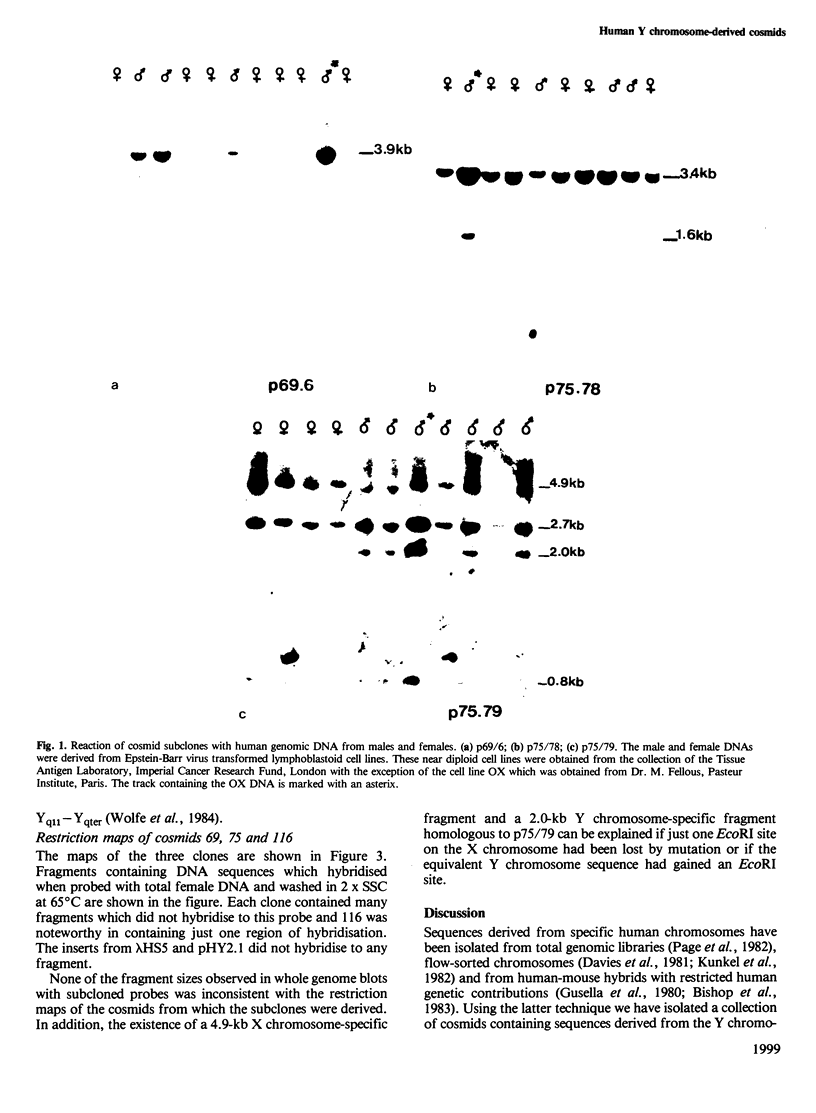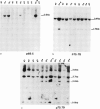Abstract
Clones containing sequences derived from the human Y chromosome have been isolated from cosmid libraries of a human-mouse hybrid cell line. These libraries were constructed in the new expression vectors Homer V and Homer VI. The collection of cosmids isolated is enriched for unique sequence DNA and only a few of the cosmids contain the tandemly repeated sequences which constitute a major portion of the Y chromosome. Three cosmids have been studied in detail. One cosmid shows extensive homology over at least 20 kb with the long arm of the X chromosome; this homology is outside the predicted homology region required for sex chromosome pairing. The other two clones contain unique sequences specific to the Y chromosome and both map to the heterochromatic region of the Y chromosome long arm.
Full text
PDF






Images in this article
Selected References
These references are in PubMed. This may not be the complete list of references from this article.
- Birnboim H. C., Doly J. A rapid alkaline extraction procedure for screening recombinant plasmid DNA. Nucleic Acids Res. 1979 Nov 24;7(6):1513–1523. doi: 10.1093/nar/7.6.1513. [DOI] [PMC free article] [PubMed] [Google Scholar]
- Bishop C. E., Guellaen G., Geldwerth D., Voss R., Fellous M., Weissenbach J. Single-copy DNA sequences specific for the human Y chromosome. Nature. 1983 Jun 30;303(5920):831–832. doi: 10.1038/303831a0. [DOI] [PubMed] [Google Scholar]
- Bostock C. J., Gosden J. R., Mitchell A. R. Localisation of a male-specific DNA fragment to a sub-region of the human Y chromosome. Nature. 1978 Mar 23;272(5651):324–328. doi: 10.1038/272324a0. [DOI] [PubMed] [Google Scholar]
- Burgoyne P. S. Genetic homology and crossing over in the X and Y chromosomes of Mammals. Hum Genet. 1982;61(2):85–90. doi: 10.1007/BF00274192. [DOI] [PubMed] [Google Scholar]
- Chen C. W., Thomas C. A., Jr Recovery of DNA segments from agarose gels. Anal Biochem. 1980 Jan 15;101(2):339–341. doi: 10.1016/0003-2697(80)90197-9. [DOI] [PubMed] [Google Scholar]
- Chia W., Scott M. R., Rigby P. W. The construction of cosmid libraries of eukaryotic DNA using the Homer series of vectors. Nucleic Acids Res. 1982 Apr 24;10(8):2503–2520. doi: 10.1093/nar/10.8.2503. [DOI] [PMC free article] [PubMed] [Google Scholar]
- Colbère-Garapin F., Horodniceanu F., Kourilsky P., Garapin A. C. A new dominant hybrid selective marker for higher eukaryotic cells. J Mol Biol. 1981 Jul 25;150(1):1–14. doi: 10.1016/0022-2836(81)90321-1. [DOI] [PubMed] [Google Scholar]
- Cooke H. J., Hindley J. Cloning of human satellite III DNA: different components are on different chromosomes. Nucleic Acids Res. 1979 Jul 25;6(10):3177–3197. doi: 10.1093/nar/6.10.3177. [DOI] [PMC free article] [PubMed] [Google Scholar]
- Cooke H. J., Schmidtke J., Gosden J. R. Characterisation of a human Y chromosome repeated sequence and related sequences in higher primates. Chromosoma. 1982;87(5):491–502. doi: 10.1007/BF00333470. [DOI] [PubMed] [Google Scholar]
- Davies K. E., Young B. D., Elles R. G., Hill M. E., Williamson R. Cloning of a representative genomic library of the human X chromosome after sorting by flow cytometry. Nature. 1981 Oct 1;293(5831):374–376. doi: 10.1038/293374a0. [DOI] [PubMed] [Google Scholar]
- Davis R. M. Localisation of male determining factors in man: a thorough review of structural anomalies of the Y chromosome. J Med Genet. 1981 Jun;18(3):161–195. doi: 10.1136/jmg.18.3.161. [DOI] [PMC free article] [PubMed] [Google Scholar]
- Deininger P. L., Jolly D. J., Rubin C. M., Friedmann T., Schmid C. W. Base sequence studies of 300 nucleotide renatured repeated human DNA clones. J Mol Biol. 1981 Sep 5;151(1):17–33. doi: 10.1016/0022-2836(81)90219-9. [DOI] [PubMed] [Google Scholar]
- Dhar R., McClements W. L., Enquist L. W., Vande Woude G. F. Nucleotide sequences of integrated Moloney sarcoma provirus long terminal repeats and their host and viral junctions. Proc Natl Acad Sci U S A. 1980 Jul;77(7):3937–3941. doi: 10.1073/pnas.77.7.3937. [DOI] [PMC free article] [PubMed] [Google Scholar]
- Flavell R. A., Kooter J. M., De Boer E., Little P. F., Williamson R. Analysis of the beta-delta-globin gene loci in normal and Hb Lepore DNA: direct determination of gene linkage and intergene distance. Cell. 1978 Sep;15(1):25–41. doi: 10.1016/0092-8674(78)90080-6. [DOI] [PubMed] [Google Scholar]
- Frommer M., Prosser J., Vincent P. C. Human satellite I sequences include a male specific 2.47 kb tandemly repeated unit containing one Alu family member per repeat. Nucleic Acids Res. 1984 Mar 26;12(6):2887–2900. doi: 10.1093/nar/12.6.2887. [DOI] [PMC free article] [PubMed] [Google Scholar]
- Gluzman Y. SV40-transformed simian cells support the replication of early SV40 mutants. Cell. 1981 Jan;23(1):175–182. doi: 10.1016/0092-8674(81)90282-8. [DOI] [PubMed] [Google Scholar]
- Goodfellow P. N., Banting G., Trowsdale J., Chambers S., Solomon E. Introduction of a human X-6 translocation chromosome into a mouse teratocarcinoma: investigation of control of HLA-A, B, C expression. Proc Natl Acad Sci U S A. 1982 Feb;79(4):1190–1194. doi: 10.1073/pnas.79.4.1190. [DOI] [PMC free article] [PubMed] [Google Scholar]
- Goodfellow P. N., Tippett P. A human quantitative polymorphism related to Xg blood groups. Nature. 1981 Jan 29;289(5796):404–405. doi: 10.1038/289404a0. [DOI] [PubMed] [Google Scholar]
- Goodfellow P., Banting G., Sheer D., Ropers H. H., Caine A., Ferguson-Smith M. A., Povey S., Voss R. Genetic evidence that a Y-linked gene in man is homologous to a gene on the X chromosome. Nature. 1983 Mar 24;302(5906):346–349. doi: 10.1038/302346a0. [DOI] [PubMed] [Google Scholar]
- Grosveld F. G., Lund T., Murray E. J., Mellor A. L., Dahl H. H., Flavell R. A. The construction of cosmid libraries which can be used to transform eukaryotic cells. Nucleic Acids Res. 1982 Nov 11;10(21):6715–6732. doi: 10.1093/nar/10.21.6715. [DOI] [PMC free article] [PubMed] [Google Scholar]
- Gusella J. F., Keys C., VarsanyiBreiner A., Kao F. T., Jones C., Puck T. T., Housman D. Isolation and localization of DNA segments from specific human chromosomes. Proc Natl Acad Sci U S A. 1980 May;77(5):2829–2833. doi: 10.1073/pnas.77.5.2829. [DOI] [PMC free article] [PubMed] [Google Scholar]
- Hanahan D., Meselson M. Plasmid screening at high colony density. Gene. 1980 Jun;10(1):63–67. doi: 10.1016/0378-1119(80)90144-4. [DOI] [PubMed] [Google Scholar]
- Hanahan D. Studies on transformation of Escherichia coli with plasmids. J Mol Biol. 1983 Jun 5;166(4):557–580. doi: 10.1016/s0022-2836(83)80284-8. [DOI] [PubMed] [Google Scholar]
- Hope R. M., Goodfellow P. N., Solomon E., Bodmer W. F. Identification of MIC5, a human X-linked gene controlling expression of a cell surface antigen: definition by a monoclonal antibody raised against a human X mouse somatic cell hybrid. Cytogenet Cell Genet. 1982;33(3):204–212. doi: 10.1159/000131756. [DOI] [PubMed] [Google Scholar]
- Ish-Horowicz D., Burke J. F. Rapid and efficient cosmid cloning. Nucleic Acids Res. 1981 Jul 10;9(13):2989–2998. doi: 10.1093/nar/9.13.2989. [DOI] [PMC free article] [PubMed] [Google Scholar]
- Klebe R. J., Chen T., Ruddle F. H. Controlled production of proliferating somatic cell hybrids. J Cell Biol. 1970 Apr;45(1):74–82. doi: 10.1083/jcb.45.1.74. [DOI] [PMC free article] [PubMed] [Google Scholar]
- Kunkel L. M., Tantravahi U., Eisenhard M., Latt S. A. Regional localization on the human X of DNA segments cloned from flow sorted chromosomes. Nucleic Acids Res. 1982 Mar 11;10(5):1557–1578. doi: 10.1093/nar/10.5.1557. [DOI] [PMC free article] [PubMed] [Google Scholar]
- Marcus M., Tantravahi R., Dev V. G., Miller D. A., Miller O. J. Human-mouse cell hybrid with human multiple Y chromosomes. Nature. 1976 Jul 1;262(5563):63–65. doi: 10.1038/262063a0. [DOI] [PubMed] [Google Scholar]
- Page D., de Martinville B., Barker D., Wyman A., White R., Francke U., Botstein D. Single-copy sequence hybridizes to polymorphic and homologous loci on human X and Y chromosomes. Proc Natl Acad Sci U S A. 1982 Sep;79(17):5352–5356. doi: 10.1073/pnas.79.17.5352. [DOI] [PMC free article] [PubMed] [Google Scholar]
- Pearson P. L., Bobrow M. Definitive evidence for the short arm of the Y chromosome associating with the X chromosome during miosis in the human male. Nature. 1970 Jun 6;226(5249):959–961. doi: 10.1038/226959a0. [DOI] [PubMed] [Google Scholar]
- Rigby P. W., Dieckmann M., Rhodes C., Berg P. Labeling deoxyribonucleic acid to high specific activity in vitro by nick translation with DNA polymerase I. J Mol Biol. 1977 Jun 15;113(1):237–251. doi: 10.1016/0022-2836(77)90052-3. [DOI] [PubMed] [Google Scholar]
- Schmidtke J., Schmid M. Regional assignment of a 2.1-kb repetitive sequence to the distal part of the human Y heterochromatin. Hum Genet. 1980;55(2):255–257. doi: 10.1007/BF00291774. [DOI] [PubMed] [Google Scholar]
- Singh L., Purdom I. F., Jones K. W. Conserved sex-chromosome-associated nucleotide sequences in eukaryotes. Cold Spring Harb Symp Quant Biol. 1981;45(Pt 2):805–814. doi: 10.1101/sqb.1981.045.01.099. [DOI] [PubMed] [Google Scholar]
- Southern E. M. Detection of specific sequences among DNA fragments separated by gel electrophoresis. J Mol Biol. 1975 Nov 5;98(3):503–517. doi: 10.1016/s0022-2836(75)80083-0. [DOI] [PubMed] [Google Scholar]
- Southern P. J., Berg P. Transformation of mammalian cells to antibiotic resistance with a bacterial gene under control of the SV40 early region promoter. J Mol Appl Genet. 1982;1(4):327–341. [PubMed] [Google Scholar]
- Wolfe J., Erickson R. P., Rigby P. W., Goodfellow P. N. Regional localization of 3 Y-derived sequences on the human X and Y chromosomes. Ann Hum Genet. 1984 Jul;48(Pt 3):253–259. doi: 10.1111/j.1469-1809.1984.tb01022.x. [DOI] [PubMed] [Google Scholar]




